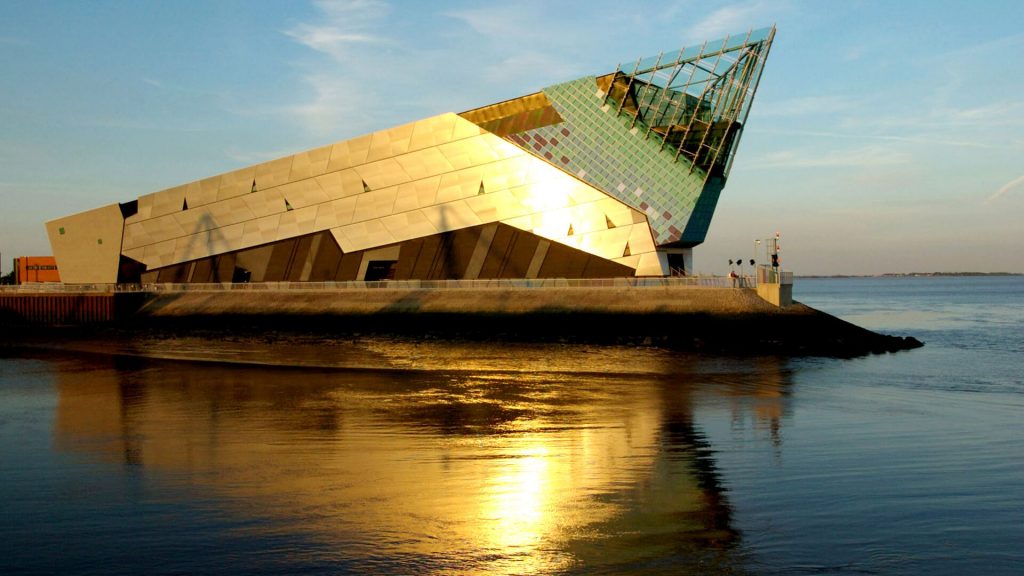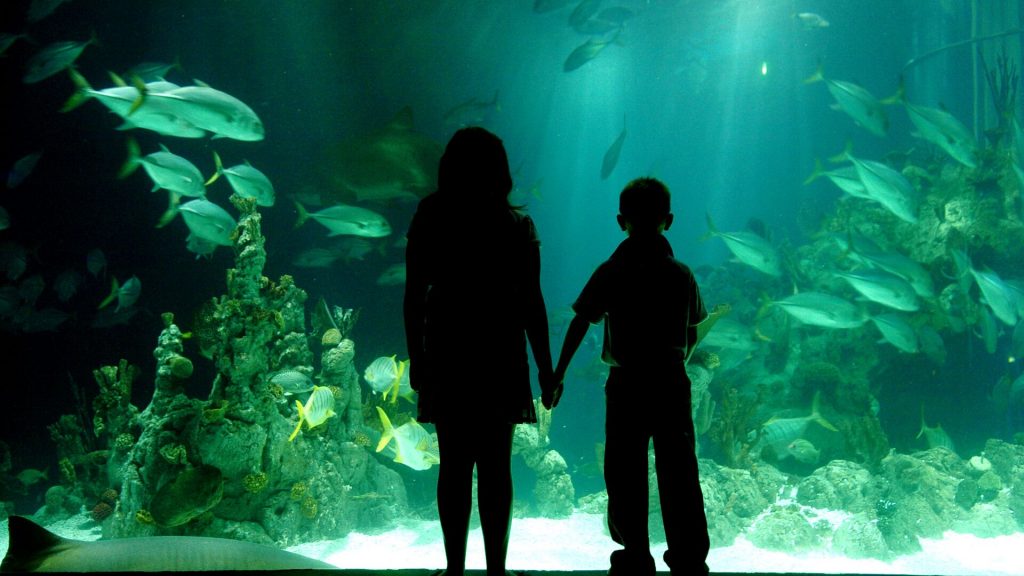Katie Parsons, Department of Geography, University of Hull
Immediately after the tidal barrier along the Humber’s north bank you arrive at Sammy’s Point. This land on the seaward junction of the river Hull and the Humber estuary was once a large shipyard run by Martin Samuelson. Hundreds of steam vessels were made here in the 1800s, but it is now home to the iconic and internationally recognised landmark that is, The Deep.

The Deep at Sunset Image: Sean Spencer, Hull News & Pictures
The UK Millennium Commission used funding raised through the UK National Lottery to assist communities in celebrating the close of the second millennium. Open since 2002, The Deep is now the most commercially successful Millennium Project and operates as an education and conservation charity. In recent years, The Deep has become an international player in marine conservation, forging partnerships with key governing bodies, such as the International Union for Conservation of Nature (IUCN), who oversee the global ‘red-listing’ of species at risk of extinction.
The Deep’s motto is “for conservation, not profit” and it plays a vital role in engaging and educating people about the environment. With its changing exhibitions and educational experiences, it provides the perfect platform to start a child’s relationship with the natural world. From introducing newly born babies to the brightly coloured swimming fish in the lagoon of light, to the inquisitive toddler copying the waddling Gentoo penguins, all the way to the aging adult staring into the endless ocean exhibit for a bit of blue therapy, The Deep provides awe, a calming environment, and a firm foundation to start growing the positive relationship we all need with the natural environments around us. The Deep introduces its visitors to the diversity of life here on planet Earth, and our need to engage and care for the ecosystems within it. With constantly changing exhibitions and learning resources available, this knowledge and love of the natural world builds with each visit, deepening both children and adults’ interest, knowledge, and enquiry alike.

A young boy and girl look at fish in the aquarium, The Deep Image: Sean Spencer, Hull News & Pictures
There are synergies between the work The Deep do and my own research where I seek to find new ways to support children and young people in their engagement in environmental social action. My own research addresses the relationships people have with the environment and how education and wellbeing are connected to nature.
To effectively engage young people in environmental issues, you need to mix three key ingredients: Knowledge, Skills, and Self-belief.
Developing a knowledge base through environmental education is seen as the most important ingredient in changing life behaviours, yet many have shown that knowledge about biodiversity and climate change alone is not enough to fully change behaviours. Indeed, Otto and Pensini (2017) highlight that a strong emotional connection, or relationship, with the natural environment is necessary to make people want to act, and Chawla (2015) suggests that positive experiences of nature as a child is the most important elements in providing that connection. The Deep provides exactly this emotional connection, and very effectively combines it with education and knowledge.
But what about self-belief? Young people need to know that their voice matters, that they have a platform to be heard, taken seriously and can contribute to positive changes concerning the natural world. They need to know that the action they take matters too, and actually makes a difference. The development of self-belief is critical, and can make the biggest difference as once youth are empowered, they feel able to make these positive contributions as stakeholders within their own communities. My work with school children in Withernsea has shown how, when armed with some knowledge and provided with some digital skills training, young people engaged and took action to communicate intergenerational stories of coastal change in their own community. The INSECURE project has built on the young people’s engagement and provided them with a voice.
So, what can you start doing now to embed the love of the environment into the daily lives of yourself, your family and those around you? Well, the obvious one is buying a Deep year pass! But that aside, just getting outside as much as you can and start exploring the environment on your doorstep. The best thing is you can do that for free, it doesn’t matter where you live, there’s nature to be explored wherever you are – be it exploring the wildflowers that pepper the lawn at your local park, the birds you can see and hear from your bedroom window, or the woodlice that hang out by the moss on your neighbours front wall. If you look a little closer, there’s nature to be found, discovered and explored wherever you look.
And guess what? Sometimes that exploring can even help science! In September we will be launching the first phase of our Active Learning project, in partnership with East Riding Yorkshire Council, where we will install 25 CoastSnap photo posts along the Holderness coastline (including two at Sammy’s point). These photo posts are fixed positions where members of the public can help monitor changing coastlines through taking, and then sharing, photos from the phone cradle on the posts. These will inform scientists about the changing coastlines and will help people to make more informed decisions. But most importantly they will be engaging more people young and old in science, encouraging them to look a little closer, and become the future environmental champions our planet needs and deserves!
If you would like to learn more about any of my projects or find out about my work then you can contact me on email K.Parsons@hull.ac.uk or follow me on Twitter @ParsnipsParsons
References:
Otto, S., and Pensini, P. (2017). Nature-based environmental education of young people: Environmental knowledge and connectedness to nature, together, are related to ecological behaviour. Global Environmental Change, 47, pp 88-94.
Chawla, L. (2015) Benefits of Nature Contact for Children. Journal of Planning Literature, 30(4), pp 433-452.
